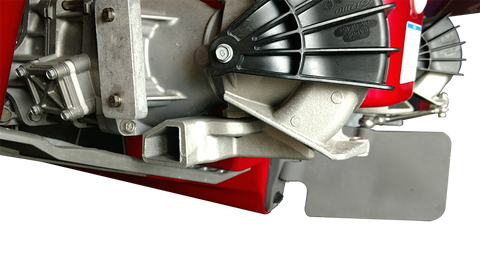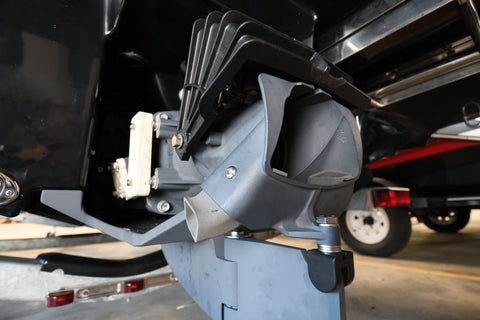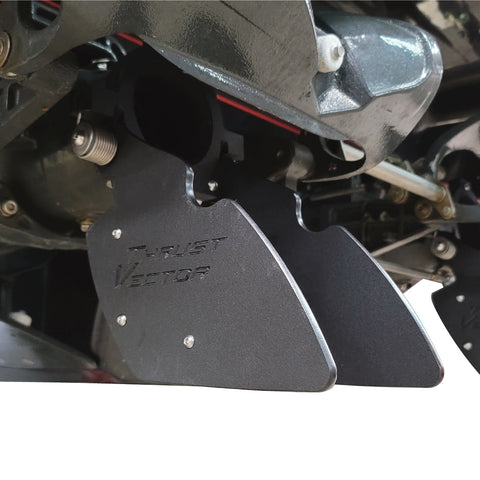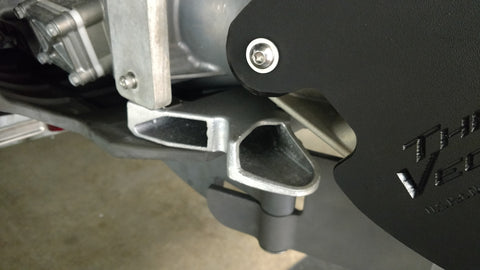Jet Boat Steering
Jet Boats use directional thrust to steer both at slow speeds and high speeds as well as to create reverse control.
This directional thrust is achieved by bending the water flow exiting the jet pump in either the left or right direction by way of a deflector nozzle and by diverting the water exiting the jet nozzle underneath the boat by way of a reverse gate which redirects the flow through an auxiliary outlet situated on the underside of the deflector nozzle.
The result is that at high speeds jet boats have tremendous turning ability and by contrast at slow speeds traditionally jet boats have minimal steering responsiveness. Over the years the makers of traditional stern drive and outboard powered boats took note of the jet boat's deficiencies with slow speed steering and in turn trained all of their sales teams to make each customer aware of the "competitive advantage" that they were in possession of. In turn Jet Boat makers began to make strides to address this slow speed steering issue and to improve upon their designs.
First, Yamaha did this with the No-Wake feature in 2006. No Wake Mode served two purposes. First it created the ideal no wake speed with the push of a button minimizing the amount of throttle adjustments needed to select the perfect no wake speed. Second it created a more control when maneuvering at slow speeds due to the increased RPMs. This new feature was not a complete solution to the slow speed steering deficiencies of the jet boat as it provided no help at all when No Wake Mode was not active. When users needed the additional control the most, such as when docking or trailer loading, No Wake Mode added far too much additional thrust to maintain control.
2010
In 2010 JetBoatPilot, a parts and accessories manufacturer who specializes in Jet Boat accessories, debuted the Patented Thrust Vector Slow Speed Steering Enhancement for Yamaha Jet Boats. This device was the first of its kind, a variable rudder system which operated like a traditional rudder at slow speeds but then rotated upward out of the water stream at higher speeds when additional control was not needed. This revolutionary device added significant slow speed control in a simple and affordable way benefiting many jet boat owners.

2012
In 2012, in response to increased market awareness of the Jet Boat's inherent weakness, Yamaha introduced their Thrust Directional Enhancer technology on their full line of boats. This advancement created a virtual rudder of sorts by deflecting water in an approximately 45 downward angle while at slower speeds. The technology had some effects on slow speed maneuverability but was not widely publicized by the company and proved to be less effective when compared to the Thrust Vector rudder system.
Later in 2012 JetBoatPilot's Thrust Vectors got a major upgrade, the Thrust Vector XL. I got a phone call one day from a customer who was asking if there was anything he could do to get some additional slow speed control for his Yamaha jet boat. I recommended the Thrust Vectors, to which he replied " I already have them and really need more control than they provide". Immediately I offered a refund to him, but before proceeding I asked him one final question. Sir, what if I went out to my shop and had my staff create a rudder which is a bit longer? If we send that to you would you be willing to test it for us and let us know what you think? His reply "Yes, I love my boat, I'm just scared to drive it at slow speeds". We did just that. We added about two inches of additional material to the bottom of each rudder and sent them to him to test.
The improvement was game changing! It was not just a little better but dramatically better. The lesson that we learned was that when the original rudder was designed it was intentionally made short enough to allow for about 3 inches of clearance from the bottom of the keel. this decision was made to help mitigate potential damage in the event of grounding the boat the boat. The idea was that if the rudder hit the bottom it could damage the boat or the jet pump components.
What we did not know at the time was that 95% of the rudder was above the bottom of the boat in what we call turbulent water. This meant that the effects that the rudder could have on control were minimal at best. What was needed was a rudder that would extend into the solid undisturbed water beneath the hull where the rudder could have some effect on control. With the addition of the added two inches of material to the existing rudders the Thrust Vector XL (for Extra Long) could now come into contact with solid undisturbed water across every fin in the water. This small change was a game changer for our company and for users everywhere!


2015
In 2015 Yamaha debuted their Articulating Keel technology on the new 24-foot platform released that year. This new rudder system was designed to address slow speed steering as well as high speed stability in a single product. For years competitors had claimed that wakeboarders and slalom skiers could cause the back end of a jet boat to be swayed while sliding out to the far left or right. Although this was not a major complaint from the skiers and wakeboarders we spoke with, Yamaha's introduction of this new technology spoke directly to high speed stability and straight-line tracking.
Over the course of the next two years Yamaha rolled out the technology on their 19 and 21-foot platforms and now all Yamaha jet boats come standard with the Articulating Keel. While very effective at addressing the high-speed stability and straight line tracking aspect of the boat's performance, the slow speed steering portion was not a complete solution. As mentioned earlier, the articulating keel requires clean non-turbulent water flowing across it to impact directional control. With only about 1/3 of the rudder finding its way into contact with non-turbulent water (on twin engine models) and due to its relative small size on single engine models, the Articulating Keel does aid in slow speed maneuverability but does not offer the same amount of control found by installing a set of Thrust Vectors.

2017
By 2017 there were three more competitors present in the jet boat market, all of which manufacture their own hulls but rely on propulsion systems made by former jet boat manufacturer Sea-Doo. These propulsion systems are similar to the Yamaha propulsion system with the exception of a few key areas. To save time and for the purposes of this discussion we'll focus on the steering characteristics of the competitive models. Just like the Yamaha jet boats BRP powered boats such as Scarab, Chaparral and Glastron use water pressure created by an enclosed impeller spinning within an impeller housing and deflected left or right by a deflector nozzle to create directional control. The difference is found when you look at the reverse steering buckets found on the BRP powered boats. Unlike the Yamaha reverse gate which is fixed to the deflector nozzle and moves with the nozzle both left and right as well as pivoting up and down, the BRP propulsion systems achieve reverse control by way of a pivoting reverse bucket which is mounted to the transom of the boat. Its only movement is in the up and down direction.
When reverse is selected by the driver the reverse bucket/buckets are lowered into place and the water exiting the deflector nozzle is pushed through large openings in the sides of the reverse bucket. This side force creates lateral force in reverse and due to this lateral force, the driver experiences a high level of reverse control with a minimum of control input needed. Conversely the Yamaha reverse system which utilizes a reverse outlet deflecting water underneath the boat is restricted to a maximum turn angle of approximately 30 degrees off the center line of the deflector nozzle. While offering more reverse speed and maximum braking ability for the driver, this system offers less turning ability while in the reverse configuration. With this perceived advantage BRP powered boat manufacturers began to highlight the fact that they possessed more control in reverse in order that they gain more sales.
What they failed to mention is that although their boats offer more reverse control, the control is counter-intuitive to the driver compared to driving a car or traditional stern drive or outboard powered boat. The driver must change the way they think when operating in reverse which takes some time to become proficient. Although Yamaha's factory reverse system provides less reverse turning ability it's design allows for intuitive control on the part of the driver, allowing them to pull from their previous automotive experience as well as any previous boating experience. When talking with customers we found that if asked to choose between more control counter-intuitively or less control intuitively more often than not customers chose intuitive control.
In April of 2017 JetBoatPilot began working on the creation of a device which is now called the Lateral Thruster. This device was designed to add additional reverse control to any Yamaha Jet Boat by way of an aftermarket accessory which could be easily installed with a minimum of tools and experience. Additionally, the device was designed to provide all of this additional control intuitively without having to train the user as to how to use the product.
We are proud to announce that in late December the all new Patent Pending Lateral Thrusters will begin shipping to customers all over the US and around the world. This new addition to JetBoatPilot's IP catalog is a perfect synergy to our already popular and still very relevant Thrust Vector XV system, the most current adaptation of the Thrust Vector XL. The Lateral Thruster provides significant additional reverse control, while doing it intuitively, as well as in a measured and precise way. By redirecting approximately 1/3rd of the reverse thrust around to a 90-degree angle from the boat's centerline we were able to achieve sufficient control while maintaining that control in a measured and precise way.
Unlike the BRP propulsion system which redirects ALL of the jet pump's thrust laterally, creating excessive and honestly intimidating reverse control, JetBoatPilot's Lateral Thruster redirects only enough water to achieve precise control in a way that the user can remain confident and in control. Let's face it, no one wants to be embarrassed around the dock, right? With these two technologies installed on your Yamaha Jet Boat we have begun to declare "You can own the most maneuverable boat on the planet"!















